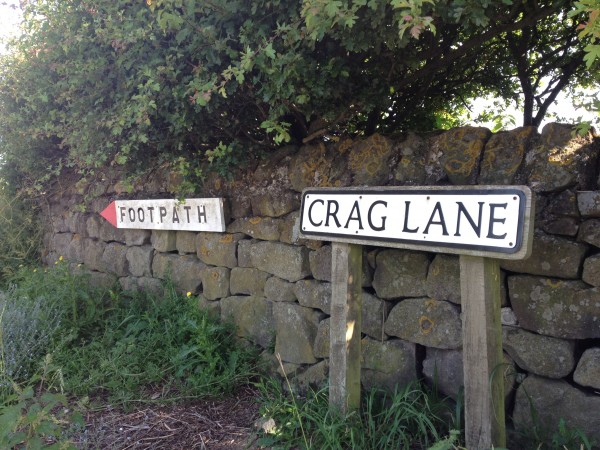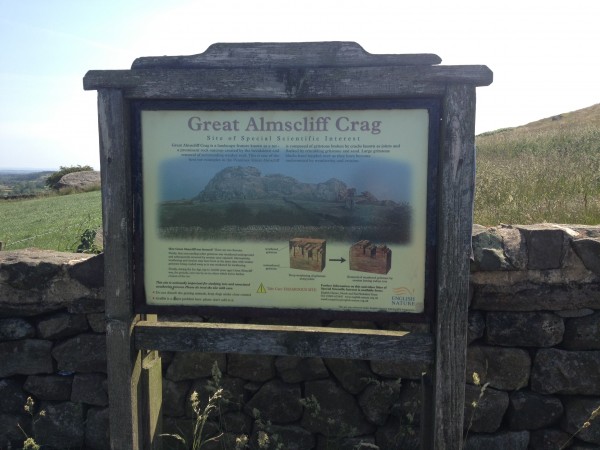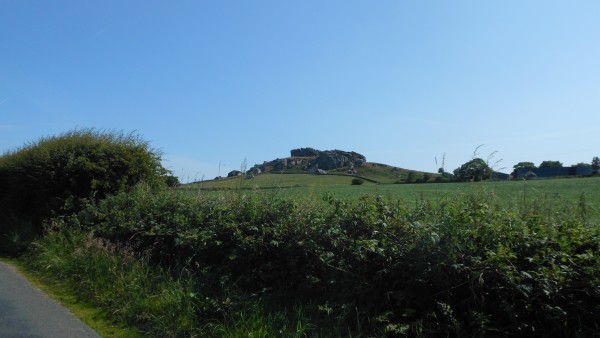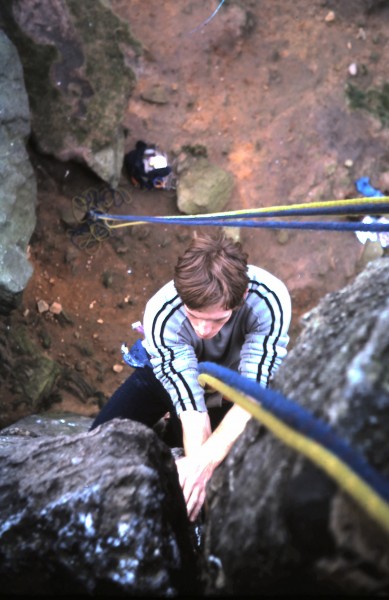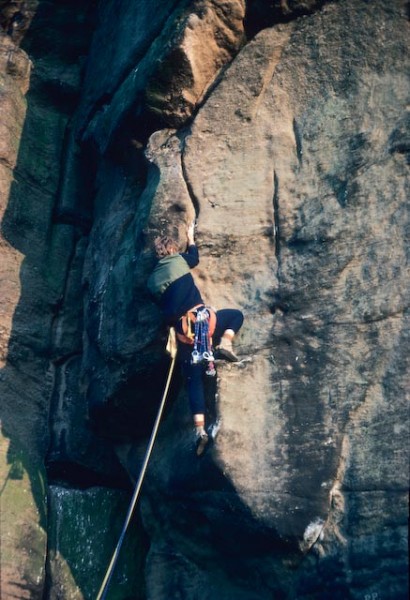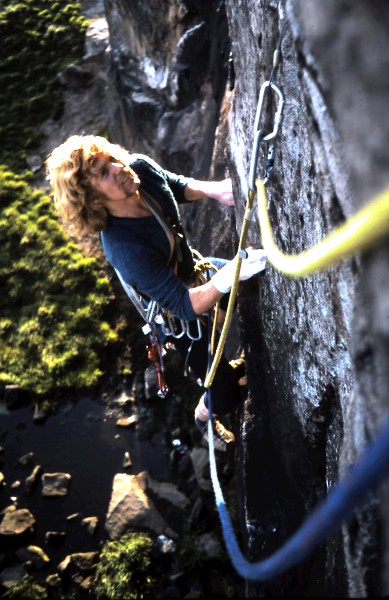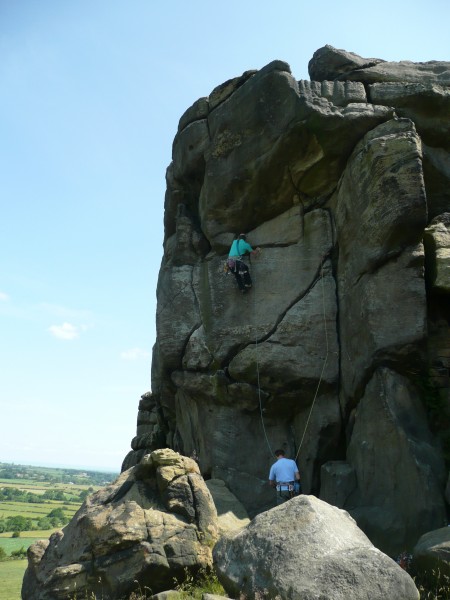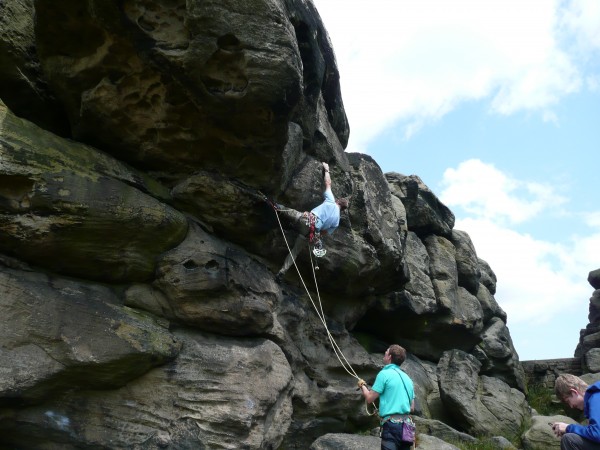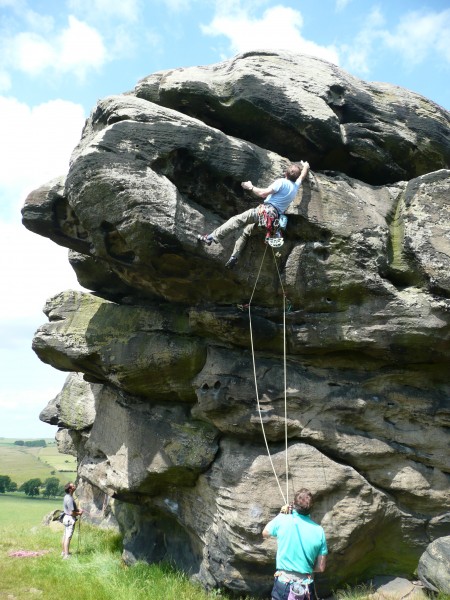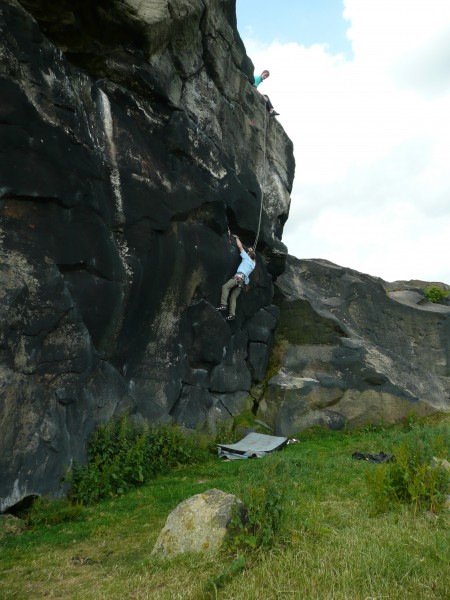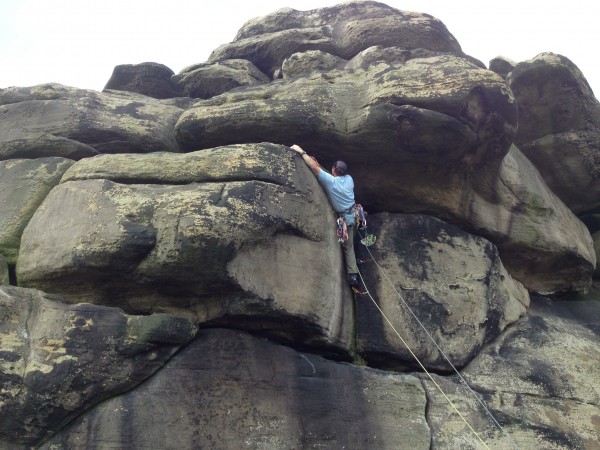Almscliff is a remarkable crag, indisputably the queen of Yorkshire gritstone it has an unrivalled concentration of classic routes that are, rich in history – even by British standards. A forcing ground for generations of climbers, a day out on the rough hewn grit of Almscliff rarely disappoints.
The crag sits pugnaciously on the skyline South West of Harrogate close to several large towns, and the city of Leeds, it’s bulging walls provide a concentration of adventures, taxing, technical and bold, the routes are best tackled with a confident approach that makes maximum use of momentum. Pausing at the crux, rather than pulling through first time, is never a good move here.
The crag has been climbed on for over a hundred years. Climbing in Tweeds and Nails a selection of notable Victorian and Edwardian climbers developed a range of techniques that they then transferred onto the crags of the Lake District, Wales, Scotland and the Alps. And to prove that nothing is new, some of the earliest recorded bouldering took place on the Virgin and Gypsy boulders beneath the crag– Norfolk Jackets and plus fours, being the norm, rather than mats, chalk and beanies.

Missing photo ID#310616

Missing photo ID#310617
Though climbed and undoubtedly recorded before hand, the Yorkshire Ramblers Club Guide of 1949 describes the established routes on the Virgin
Virgin.
A magnificent boulder with five recognised routes and several variations.
North Face. A moderately difficult traverse with good pocket holds.
Top Side. Right Corner. A steep and delicate corner climb which may be started on the North or on the East face.
Top Side. Central Face. Severe. To reach a good finishingm hold is necessary to step up boldly on poor holds.
Top Side. Left Corner. Start on the East face and finish up the South face on good holds.
South Face. Stride and Diagonal Route. V.S. From the adjacent boulder take a long stride on to the Virgin. Ascend a few feet and traverse left to sloping ledge. Pass round corner and follow sloping ledge down to left. Step out left and ascend delicately.
It is worth remembering that many of these pioneers were unusually strong – being able to do a one arm pull up was a not unheard of benchmark. Early pioneers such as Cecil Slingsby, Herbert Ingle, Fred Botterill, W Parsons and Claude Frankland explored the crag establishing routes up the obvious wide cracks and chimneys that fracture the crag. As early as the late 1800S Ingle had established a VS route @5.6 imaginatively called the ‘Traditional Climb’ on the South face. By the 1920s Claude Frankland had established several routes at this grade. Protection throughout this period was ‘rudimentary’ and unless there was a handy and significantly large spike or flake, there would be nothing to drape your hemp sling over to make a belay or runner. This remained the case until the advent of nuts, and with hemp rope. A leader fall was largely unthinkable and most ascents would have been solos.

Missing photo ID#310659

Missing photo ID#310661

Missing photo ID#310662
There seems to have been something of a hiatus between Frankland’s activity and his establishment of Frankland’s Green Crack (VS) in 1919 and the start of the Second World War. But during the war, and in the post war years Arthur Dolphin was the stand out climber, a naturally talented climber with a smooth style he tackled the features that had awaited a stronger, bolder climber, during the war years he established several classic lines; Great Western HVS 5a @ 5.8, Crack of Doom VS 4c 5.6 Demon Wall HVS 5a @5.8, and Birdlime Traverse in 1946, now graded E1 5b @5.9

Missing photo ID#310664

Missing photo ID#310665
The photo of him nonchalantly almost horizontal on the crux of Great Western, rope over his shoulder to the ground (a fall here would be very, very nasty) in plimsolls says a lot about his ability. The guidebook description from the period is ‘understated’ in it’s narrative , and grade!
14. Great Western. 40 ft. V.S.
Strenuous and exposed. Rubbers. The vertical corner crack 25 ft. to the right of the Niche, is climbed as a layback for 15 ft. until it is possible to pull out on to the left wall into a diagonal crack (for the feet). Hand traverse left on good holds until a strenuous pull can be made, over a pinnacle, into a recess where it is possible to rest. The overhanging crack above the recess is overcome by hand-jamming.
Described in the current guidebook ‘As the much heralded classic of the crag, and a good, honest knackering fight’ it is recognised as a benchmark HVS 5a (5.8) Great Western’s angle and architecture isn't revealed by the typical ‘front on’ photograph, but when you get below it, at the start it definitely is!
Dolphin wasn't much more than a gritstone specialist, he performed well elsewhere, establishing several hard classics in the Lakes; Kipling Groove on Gimmer, so named because it was ‘Ruddy Ard’. Dolphin also top roped Wall of Horrors, remarkable given its difficulty and that he would have been in plimsolls. But never got around to soloing it. Dolphin’s death, falling on an easy ice slope during a descent of the Dent du Geant robbed British climbing of it’s pre-eminent 1940s climber.
Dolphins developments have been described as setting the scene for the next big jump in standards. This came in the unlikely shape of Alan Austin. Born in 1934 Austin’s gritstone Gritstone career began in the 1950s. While he was an unimposing figure, be speckled and preferring to wear several wool jumpers, his routes were the opposite, very bold and unprotected, he soloed two of Dolphin’s top ropes, Notably falling off the crux of Western Front on his first attempt and suffering a very nasty groundfall that knocked him out. After he regained consciousness he gathered himself and did it second go (the drop zone IS awful). He also had the nerve to solo the Wall of Horrors.

Missing photo ID#310668

Missing photo ID#310667
As a teenager I pored over the iconic photos of him soloing the route in Mountain Magazine, wondering if I would ever be worthy. Like Dolphin Austin was active in the Lakes and elsewhere. Overall he did 400 new routes on Grit, 200 on Limestone and 100 on volcanic rock. But an unglamorous stickler for detail he became overshadowed by the stars of the next stage of development – a mixture of Glam Rock and Punk was about to unleash it’s talents on the crag.
In 1970, Leeds University commissioned the construction of a climbing wall by Don Robinson. Built in a corridor this early and primitive wall became a catalyst for a string of young, bold and talented climbers.

Missing photo ID#310669
John Syrett, Pete Livesy, Al Manson, Mike Hammill and Ken Wood, Ron Fawcett and others were all either users of or influenced by what the wall precipitated. Almscliff being the preeminent Gritstone crag understandably drew a lot of attention with these notables pushing the bar higher and setting standards for the next generation again to brush aside. It was this groups exploits who as a youngster I read about, avidly in each publication of Mountain, or the parochial ‘Crags’, and it was their reputations and routes that you measured yourself against.
I first visited the Almscliff in 1972, as a keen sixteen year old on a club trip from Newcastle. I remember the crag was very intimidating, for sure the most striking outcrop I had seen; steep, bulging, brooding and exotic. Far more ‘in your face’ than the sandstone of Northumberland, everything here looked very, very unforgiving. Back then commercial nuts were still pretty inadequate and I didn’t even own any EB’s. It was and still is a crag that sorts out the men from the boys.
Indeed it was here that I was introduced to EBs. Up until then I had been climbing either in alpine boots, or plimsolls, typically climbing at about ‘Severe’ level (that’s probably around 5.4), I was loaned a pair of EBs by a kind local, I thrashed my way up several burly VSs, and was given a guided tour of the crag. Desperate looking lines were pointed out in hushed tones, and the adventures of heroes such as Austin and Dolphin discussed in a suitably awed manner. It all seamed unassailably difficult. Still I was converted by the footwear, and when I got home I rapidly sold my road bike for £16 .00 (a small fortune then) bought a pair of EBs and never looked back.
My next encounter with the crag was four years later in 1976, a lot had happened in British climbing in the intervening four years, climbing walls had emerged – some more sophisticated than others. At the very least they allowed exercise to continue through the winter and even this had a profound effect. The Leeds University wall in particular became a forcing ground from which a formidable array of talent emerged, Pete Livesy, Steve Bancroft, Al Manson , Pete Kitson, Alex MacIntyre and John Syrett all used the wall and demonstrated the improvements possible with what was a very basic (if intensive) training routine.
But living in Newcastle we were somewhat isolated, and in the early days had little idea of how hard our routes in Northumberland were. We were a small cadre of climbers following on the heels of two talented local activists; John Earl and Bob Hutchinson (Bob sadly died in an accident in the Lakes). Bob and John were adept at psychological warfare and radically undergraded their routes, one Austrailia Crack was graded HVS (5.8) when in reality it was (and is) closer to 12.b. As we in the following group didn’t know any better, we (or at least I certainly) concluded that routes graded XS elsewhere must have to be superhuman…….
In particular John Syrett’s ability and contribution was legendary, reinforced by the cover photo of Mountain 28, which showed him heel hooking his way around the Encore roof.

Missing photo ID#310670
His repeat of Wall of Horrors broke the spell many of those routes held over mere mortals, and precipitated more repeats of all the harder gritstone routes became more commonplace. Syrett’s standard dropped off somewhat following a nasty accident to his hand, his life became increasingly complicated with periods of depression. Tragically he was later to fall one night into the void of Malham Cove. With no witnesses the Coroner declared a Death by Misadventure.
So in November 1976 I returned in the company of Bob Smith, another Geordie, having adopted the training regimes of the day, we were fighting fit and full of shit! We were both busily competing, (along with several others), for what seemed at the time to be the last great lines in our own sandstone crags in Northumberland. I was at the time working on a chemical plant and Bob as a ‘Roofer’. I was on strike and with a fine November day forecast, Bob agreed to bunk off and we decided on a trip to Almscliff.
Much had been reported in Mountain and other climbing rags and we were keen to see how it compared with what we were doing in our ‘County’. We were big fish in a small pond (or so we thought) – would we be like ducks out of water…
What followed was one of the best day’s cragging I‘ve ever had, conditions were perfect, bright, cold and dry and we had the crag to ourselves – apart from a fleeting visit by Ray Jardine – and I presume Mark Valance who pootled about a bit then left (I had just purchased at great expense a No 3 Friend).
We started off with Western Front, a classic Arthur Dolphin HVS, @5.8, then Bob led Western Front an XS 5c @10.c (None of the complicated E grades back then).
I then led Wall of Horrors XS 6a @ 11b/c, Clemitis and Oubliette followed, both around 10.d. We were on a roll now, Bob led Shuffle Crack 10.b then I took on Yellow Wall another high 10, Birdlime Traverse and Black Wall Eliminate fell, as did the hardest of the bunch Big Greeny at 11.c We finished off our leading with Encore 10.c, which is short but as spectacular as the photo indicates. Weary by now we finished off top roping the Ochrist Roof an 11.d. It was some day we had trotted up some of the iconic routes of the day in really good style. We headed home happy and with substantially less skin than we started.
It was of course all made possible by our c*#k headed confidence, and Helly Hansen fleece, which we discovered stuck to the grit like Velcro. Throwing a forearm over a rounded, bald finish resulted in a suprising but very satisfying latch that allowed your fingers and forearms to recover.
It was a remarkable day and like many climbing experiences much of it remains indelibly burnt into my memory. A couple of years later I enlisted in the Army and was based in the South of England for the best part of my service, in that Time a managed one trip back to Almscliff, just after the first Gulf War, stopping off en route to the Lakes I did a damp Wall of Horrors.
Life then got in the way and there were no more visits until this year, a family trip introduced my son Tim to the delights of Gritstone, and we then had to meet up with Loz prior to our trip to Yosemite.
Tim led his first VS (5.6) the Crack of Doom which takes the corner shared by Great Western, but kicks out right by an awkward crack (It was this route that revealed the value of EBs to me back in 1972).
We did a couple of other classic HVS’s Great Western which is an absolute classic, super steep and juggy.
Loz did a good job on Clemitis which was pretty greasy in the 30 degree heat. (Andy Murray was playing in the Wimbledon final in 40 degrees that day). I Led Black Wall Eliminate and we finished off with Loz leading the awkward Shuffle Crack.
Sadly it was just too hot to contemplate the harder stuff, but it’s not going anywhere and the hot weather won’t last long – This is the UK after all.
Driving back we called in at a café to get some cold drinks and as we got in the car the news of Andy Murray's win over Djokovic jumped out of the radio. Oh Perfect Day!
Some acknowledgements are required: The two photos of Benson were taken from John Gill's website, thanks John. Some scans were taken from early Mountain mags. Cumbrian Rock by Trevor Jones and Geoff Milburn and the latest Yorkshire Gritsone Guide are fantastic publications full of historic material. The Slingsby image was taken from the Slingsbys genealogy site. As usual if there are any complaints I'll pull an image. The Yorkshire Mountaineering Club allow the use of the 1949 guide with suitable acknowledgement: Stembridge, H.L. (1949) Almscliff - A Key to Climbs. Yorkshire Ramblers' Club Journal Volume 7 Number 25: pp213-227. Leeds: YRC.
Have fun!
Steve
